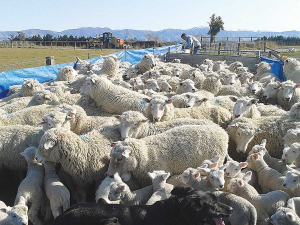Woollen covers that keep newborn lambs safe, warm
A Christchurch manufacturer of woollen covers for newborn lambs says his covers pay dividends in survival rates and liveweight gains, especially at a time when farmers are feeling the economic pinch.
 Early weaning can be particularly useful in hoggets, as they typically lamb later than the mixed-age ewes.
Early weaning can be particularly useful in hoggets, as they typically lamb later than the mixed-age ewes.
Early weaning of lambs can be a valuable management tool that can advantage both ewes and lambs.
With the right quantity of legume-based forages, early-weaned lambs can grow as fast – if not faster – than their unweaned equivalents on traditional ryegrass and clover pastures.
Early-weaned ewes can either be sold early, which frees up feed for other stock, or benefit from having more time to recover body condition before mating.
In late lactation, all lambs, but especially multiples, receive very little nutrition from the ewe. When grass growing conditions are below optimal, the ewes are competing with their lambs, compromising the performance of both.
By weaning them early onto correctly managed, high quality, legume-based forages, the lambs are given more opportunity to realise their genetic growth potential. Weaned lambs should be allowed unrestricted access to high quality, legume dominant pasture (between 1200 kgDM/ha and 2000 kgDM/ha). Or, ideally, a legume-based crop with a height of 7-10 cm.
If lambs are being weaned onto a crop, they should be given time to adjust to a change in feed. Running the ewes and lambs onto the crop for a few days before weaning, then running the lambs back onto the crop after weaning, will minimise the weaning check.
In trials run at Massey University, researchers looked at weaning lambs early, at a minimum liveweight of 16kgLW, onto either a herb-clover mix or a lucerne sward. They found heavier lambs (over 20kg) coped best with early weaning, but the quality of the forage on offer was the biggest determinant of how lambs grow post-weaning.
Early weaning is most effective in seasons when grass growth is limited (pasture covers of under 900 kgDM/ha), and lambs weaned early are offered a herb-clover mix with a minimum pasture cover of 7cm.
Farmers using lucerne, should follow Good Management Practice for lucerne grazing.
Early weaning can be a flexible stock and pasture management tool, used to benefit the whole farm system. For example, weaning a proportion of the flock early means some ewes can be used as a grazing management tool to prepare pastures for when the balance is weaned later.
Early weaning can be particularly useful in hoggets, as they typically lamb later than the mixed-age ewes but mated as two-tooths at the same time. This means that despite their age, they are required to regain body condition more quickly than the older ewes.
Maximising lamb growth rates in the late spring, early summer period has on-going benefits. They are finished faster and therefore consume less feed postweaning. It is easier to breed from heavier ewe lambs as hoggets, and there is flexibility to hold them back later when feed resources are more limited.
Heavy lambs require fewer animal health remedies and less labour inputs, so any management strategy that helps maximise lamb growth rates is worth considering.
Key management factors include:
The National Wild Goat Hunting Competition has removed 33,418 wild goats over the past three years.
New Zealand needs a new healthcare model to address rising rates of obesity in rural communities, with the current system leaving many patients unable to access effective treatment or long-term support, warn GPs.
Southland farmers are being urged to put safety first, following a spike in tip offs about risky handling of wind-damaged trees
Third-generation Ashburton dairy farmers TJ and Mark Stewart are no strangers to adapting and evolving.
When American retail giant Cosco came to audit Open Country Dairy’s new butter plant at the Waharoa site and give the green light to supply their American stores, they allowed themselves a week for the exercise.
Fonterra chair Peter McBride says the divestment of Mainland Group is their last significant asset sale and signals the end of structural changes.

OPINION: Your old mate welcomes the proposed changes to local government but notes it drew responses that ranged from the reasonable…
OPINION: A press release from the oxygen thieves running the hot air symposium on climate change, known as COP30, grabbed your…